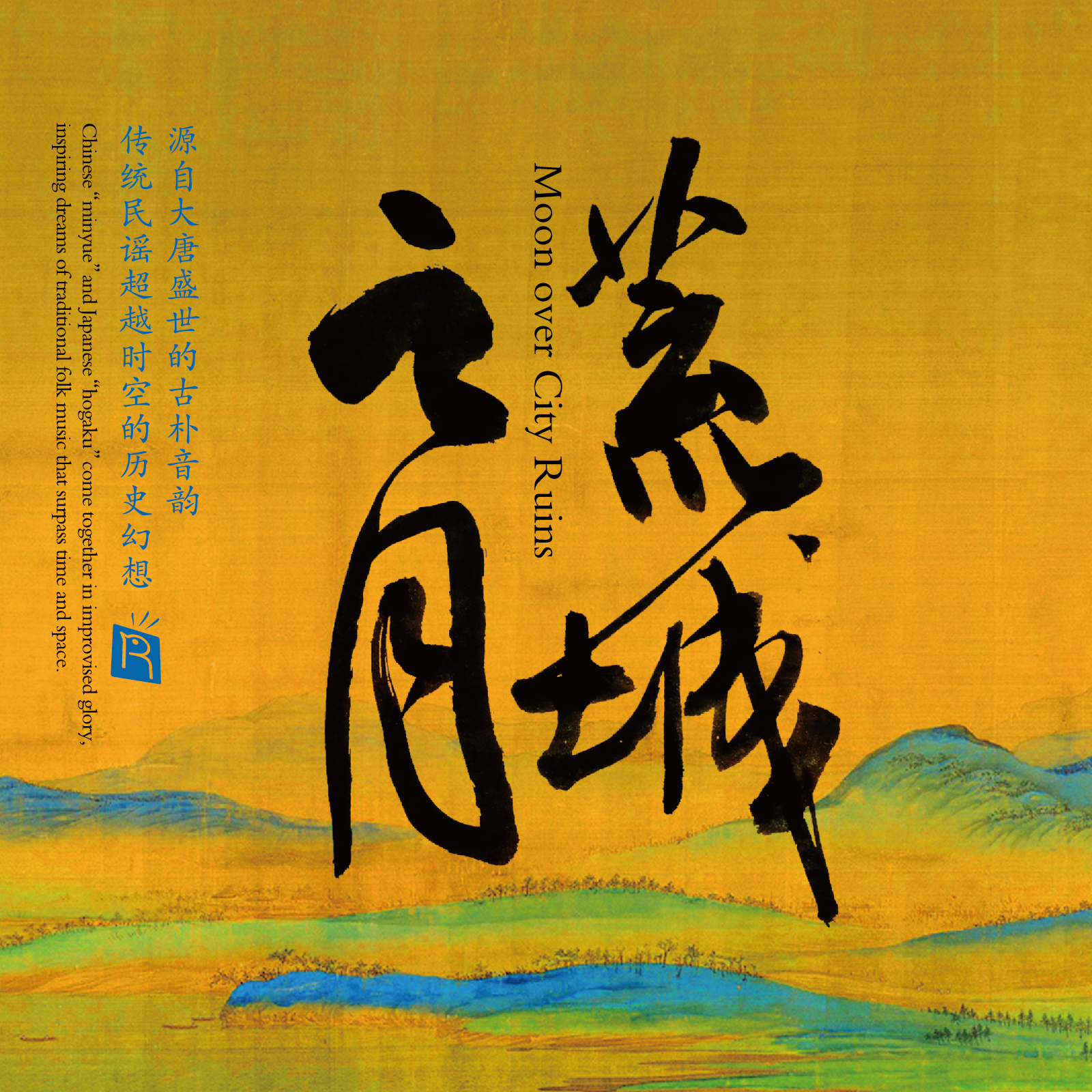荒城之月

前言:
红烛的焰光,点亮深沉的夜色。觥筹交错的喧嚣,展开欢愉的绘卷。通透铿锵的琵琶,在人影绰绰的屏风后鸣响。空灵悠长的尺八,在摇曳的素雅纱帐中飘荡。饱满洒脱的鼓声,响彻雕栏玉砌的楼阁,在迢遥而氤氲的时空深处,激扬历史的浪涛。千年时光转瞬即逝,唯有那抑扬顿挫的胡琴,徘徊在幽寂的圆月下,为一座荒凉倾颓的城池,倾诉繁华褪尽的沧桑。
1400年前的大唐长安,威名远震,四海朝拜。政治、经济昌荣的盛景,促生了丰茂多姿的音乐文化。金碧堂皇的宫阙里,恢弘的乐舞技惊四座,曼妙的笙歌绕梁不绝。这壮阔绚烂的景象,令远道而来的日本遣唐使团为之震撼,并使他们在此后的二百年间,以汹涌巨浪中飘摇沉浮的木船,载去了众多起源于华夏大地的乐器与音律,让盛唐的音乐文化,在东瀛之国落地生根。高耸的天守之上,对酒当歌的英豪,倾听着承袭自大明宫的乐声,写下雄浑悲怆的诗句。空寂寥落的禅院里,修行者踏着飘散的落樱,吹奏那渡海而来的清雅曲调。湍急而明澈的河川旁,牧牛的少年,在异国乐器的伴奏下,传唱着不知名的歌谣。
音乐制作人叶云川,幼时大量阅读中国古代文学,由此产生了对传统文化的深刻理解和热爱。2018年,他曾凭借专辑《明月映敦煌》那华美的乐音,带人重新审视唐朝与敦煌的厚重历史。如今,他再度怀着对中国古代音乐繁荣盛景的深情怀念,前往作为唐文化最重要承继者之一的日本,为那座湮灭在时光深处的长安城,找寻现世尚存的几缕古朴音韵。此次召集中日优秀青年演奏家,于东京都神奈川县一座能够容纳1200名观众的音乐厅,以中华国乐与日本邦乐的即兴合奏,演绎经典民谣。尺八、琵琶、三味线、太鼓等特色乐器,皆于唐代东渡沧海传入日本,体现了日本自古而今对中华国乐传统的保存、承继和发扬。由旅日音乐家毛丫演奏的古筝、北京演奏家杨雪的二胡等中国乐器,与尺八演奏家长谷川将山、太鼓演奏家糸原昌史的日本乐器之间,展开了精彩纷呈的音乐对话,令绵延千年的两国文化交流历程重现眼前。
此张专辑,被叶云川誉为十五年来最具戏剧性和张力的作品。他十三岁时曾以吉他弹奏过,并为之深深动容的日本名曲《荒城之月》,成为了整张专辑的灵魂。乐曲兼具枯山水般充满哲思的空寂意境,以及仿佛火山喷发式的情感起伏,带着慷慨苍凉的历史情愁,展开如同黑泽明史诗电影般恢弘壮阔的历史幻想。《最上川舟歌》、《拉网小调》等日本传统民谣,以优美舒缓的旋律,带人领略东瀛列岛的清新景色。《黄杨扁担》、《落水天》等中国小调的加入,则为专辑古朴幽远的氛围,增添了几分蓬勃的乡野生活趣致,令人回味无穷。日本资深录音师小岛幸雄匠心精湛,运用顶级模拟系统捕捉音乐每个细节,中国录音大师李大康功力超凡,混音再现古代中国古典艺术韵味悠长。
此刻,请跟随音乐,怀着赤诚的心愿,穿越千年历史幻想,跨越那一座交融文化与情感的桥梁,在东渡千年的盛唐余音中,追溯故土音乐流传的渊源脉络,领会古代中国兼收并蓄的精神气韵。在辽阔的苍穹下,在空寂的风中,仰望那一轮恒久不变的圆月,回顾沧桑人世间的荣枯盛衰,悲欢离合。以此跌宕乐声,唤醒一个繁华若梦的音乐盛世。
听尺八的悠远空寂 听古筝的铿锵抑扬 听长安城的笙歌乐舞 觥筹交错的喧嚣
听纷扬的樱雨 听绚烂唯美的生存与寂灭 听东渡千年的盛唐余音 在历史的浪潮中回荡
Foreword:
Crimson candlelight illuminates the dark night. The silence is broken by the cacophony of chatter and cups hastily placed on tables only to be lifted away immediately. The gentle song of a biwa somehow breaks through all of it, as if on a different plane. The ethereal shakuhachi weaves its song from beneath a gauze canopy. The thunderous roar of the drums resonate throughout the floors of the inn, penetrating deep into its corners, making way for the wave of memories that ensue. Even after more than a millennium, the huqin still plays its aching song, the moon above accompanying it through dynasty after dynasty, long after the city has fallen to ruin and disappeared from living memory.
The Tang capital Chang’an, now known as Xi’an, was during its heyday in 14th century one of the world’s most populous cities, and an impressive cosmopolitan center of economy, politics and culture, which gave rise to incredible breakthroughs in music. Throughout the beautiful, gilded palace halls song and dance were always to be heard, and were a treat for anyone fortunate enough to witness them first-hand. This splendid musical array soon caught the attention of the kentoushi (Japanese ambassadors to Tang China), who for the next two centuries would study these arts, and bring their knowledge of them, along with musical scores and instruments, across the raging sea back to their homeland, thus perpetuating the culture of the Tang dynasty there. These bold songs from Daming Palace could be heard throughout the castles of Japan, during festive banquets and solemn ceremonies, inspiring many poets to leave behind works full of vigor and sadness. Even in the Zen gardens of Buddhist temples, as the monks strolled past the falling cherry blossom petals, they would play melodies originating from the Great Tang. And on the banks of rivers in the countryside, young cowherd boys would hum tunes, not knowing how far they travelled to reach them.
Rhymoi Music producer Ye Yunchuan, has been fascinated by classical Chinese music since his childhood, and has cultivated a deep understanding and affection for it. In 2018, his album Moonlight glow over Dunhuang, showed the world the marvel that is the rich history of Dunhuang Grottoes and the Tang Dynasty. Here, he once again is driven by his deep admiration for Chinese classical music to bring the listener to the most important curator of Tang culture—Japan. Though the original palaces of Chang’an no longer stand, its spirit still lives on. Mr. Ye has called upon a group of talented musicians from both Japan and China, and in a 1200-seat music hall in Kanagawa, reveals a stunning portrayal of Chinese folk music and Japanese hogaku, featuring improvised performances of classic pieces. The shakuhachi, Japanese flute, Japanese biwa and taiko drums all originated from Tang China, and today Japan is the world’s greatest purveyor of extant classical songs from this era. The Outstanding young instrumentalist Mao Ya plays the guzheng and other Chinese instruments, to shape the dialogue with a range of Japanese instruments for an incredible cultural exchange spanning millennia.
This album is the most theatrical and tightly crafted work of Ye Yunchuan’s professional career spanning more than 15 years. The classic Japanese song Moon over City Ruins, which he played onstage on the guitar at the age of 13 left a deep impression on him that would shape his future life and career, serves as the main inspiration for the album. The song creates a philosophical atmosphere of a desolate and lonesome landscape. Cascades and crescendos punctuate the score, tranporting the listener to a time when life was simpler yet still full of tumult, as captured so elegantly by the films of Kurosawa Akira. Traditional Japanese folk songs like Song of the Mogami River and Net Pulling Canzonet(Solan Bushi), with their gentle, relaxing melodies, evoke the rustic countryside of feudal Japan. With the addition of Chinese folk songs, like Boxwood Carrying Pole and Rainy Day, the grassroots, rustic feel is given additional flavor and authenticity.
Ye Yunchuan has once again created a bridge spanning cultures, drawn together through a spectrum of emotions, taking you to the homeland of hogaku, and even further back to where it originated, giving you a small yet satisfying taste of this incredible era of musical history. Amidst the myriad stars, high above the ever restless clouds, sits the cool, translucent moon, always silent yet always watching, as generation after generation takes the world we live in in a new direction. Such a patient and loyal guardian deserves a musical homage of epic proportions.